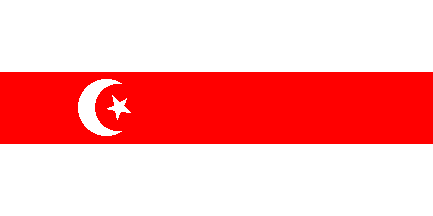 image
by Ivan Sache, 18 September 1999
image
by Ivan Sache, 18 September 1999
Last modified: 2013-12-02 by rob raeside
Keywords: belarus | tatar | tartar | tataria | tartary |
Links: FOTW homepage |
search |
disclaimer and copyright |
write us |
mirrors
 image
by Ivan Sache, 18 September 1999
image
by Ivan Sache, 18 September 1999
See also:
This flag is listed under number 101 at the chart "Flags
of Aspirant Peoples" [asp]
as : " Ak-Rusya Tatar (Tatars) - Belorussia." -
Horizontal white-red-white with white crescent and star in red
stripe, shifted to the hoist.
Ivan Sache, 16 September 1999
"Ak" means "white" in Tatar -- so
"Akrusa^" is a literal translation of "Belorossia^
/ Belarush" ("White Russia"). My Soviet atlas doesn't list any Tatar minority in Belarus
Antonio Martins, 16 September 1999
My soviet mini-atlas shows a Russian minority and areas in
northwestern Belarus of mixed Belorussian/Polish population.
Anyway, the minority situation in the Soviet Union was extremely
complex, and these atlases tend to only list the larger
minorities (or at least the "politically correct"
larger minorities). Therefore it is not to exclude the existence
of Tatars in Belarus...
Jorge Candeias, 24 September 1999
Confirmed: in Fischer Weltalmanach 1999 - in 'Weissrussland'
(Belarus) there is a minority of 'Tataren' - Tatars.
Jarig Bakker, 24 September 1999
According to Basau and Kurkou [bku94],
this is flag of Belarusian Association of Tatars-Muslims "Al
Ketab" (Belaruska Zhurtavannya Tatarau-Musulman "Al
Ketab"). Association was created in 1990 and flag was
probably adopted in the same time.
Tatars of former Grand Duchy of Lithuania live now in Poland,
Belarus and Lithuania, and a small number also in Ukraine. The
number of them all is about 16 000. In July 2001 the Association
of Tatars of Belarus, Lithuania, Poland and Ukraine was created
in Sokolka (Poland).
Grzegorz Skrukwa, 17 May 2002
I have seen references to Tartars living in the Kingdom of
Poland (see Polish Tatars) and
Lithuania, specifically in areas which are now parts of
Belarus. I believe that some of them were refugees from the
protracted strife on the steppe, which followed the Mongol
conquest, and some were prisoners of war captured by one of the
Polish Kings and transported along with their families to provide
forced labor on Polish estates.
David L. Barrett, 8 December 2002